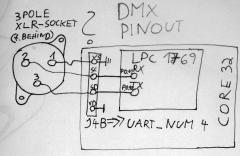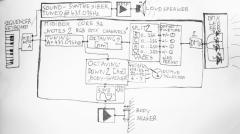Search the Community
Showing results for tags 'DMX'.
-
I want to convert Midi-In-Core (not USB-midi)> DMX-Out Core (MAX 485 Circuit) but in the DMX-Examples i read: // For now disable UART as we will be using DMX #define MIOS32_DONT_USE_UART suggest that i cant use Midi-Input then? What do i have to do to get it working?
- 10 replies
-
From the album: Notes2Light (DMX-RGBW-LED-Based)
swapping from LPC17 to STM32F4 dont bring DMX to live -
Idea: it is inpired by the work of Andreas Körber and his "WortKraftSchwingung" Input: Midi notes Output1: DMX R-G-B values Destination1: RGBW-LED-PAR. Output2: LFO Audio Output 4 Bodyshacker a standart audio setup with a Midi-Sound-Synthesizer which is tuned to a specific frequency, a=430-445hz this tuning has to be set in the Converter-Software, because the converter gets only notes not frequencys... Hardware: switched to STM32F4 Stairville LEDPAR36 - RGBW-LED-PAR Converting Idea: is to octave the sound frequency as long we see it... since all octaves are sounding great...and some greater...the visible frequency then maybe also...and anyway - its a cool effect on stage. so what has to be calculated? we have hearable-sound-frequency in Herz [hz] we want to calculate the Visible color frequency in NanoMeter [nm] for example: 1. a note produce a sound of 100hz: float midi[127] = {}; //represent Midinote 0-127 - and its value is a Frequency in [hz] u32 actualnote = 69; // where 69 is A3 named A (which is tuned with "tuning" Variable above) s32 notecount = 0; // only a counter variable to calculate the note frequencys. float tuning = 431; //represent the tuning of "Kammerton A3" for (notecount = 0; notecount < 127; ++notecount) //calculte all 127 notes and frequencys {midi[notecount] = tuning * pow(2, (float)(notecount - 69)/12);} midi[actualnote] ///(=outputs the Frequency in [hz] for the actual played note 2. calculate the visible octave of 100hz & divide lightspeed by that frequency (hz*42th octave) / 10^12 =THz >>>> (100hz*2^42)/10^12 = 439.804THz lightspeed/THz=nm >>>> 299792,458/439.804 = 681.640nm float nm; long thz; thz = ( (midi[actualnote] * pow(2, 42) ) / 1000000000000); nm = 299792.458 / (float)thz; is the result not in the visible Spectrum > not between 790 and 390nm? whats then?::: i figured out that D2-D3 is the visible octave (midi nr 42 - 54) @431hz A3 tuning: F2=753nm, F3=376nm is it under 42? +12 notes until it is above or equal F2, how many octaves?>how many change the whithe LED-Level.... is it above 53? -12 notes until it is under or equal F3, how many octaves?>how many change the whithe LED-Level....::: //transpose the note to the visible Octave (NoteNr41-53) and save the octave Nr for further LED-White Parameters. octaveCOUNT = 4; //4 is the visible octave visiblenote = midinote; if (midinote < 42) {visiblenote = midinote + 12; --octaveCOUNT; // below visible octave? if (visiblenote < 42) {visiblenote = visiblenote + 12; --octaveCOUNT; if (visiblenote < 42) {visiblenote = visiblenote + 12; --octaveCOUNT; if (visiblenote < 42) {visiblenote = visiblenote + 12; --octaveCOUNT; }}}} if (midinote > 54) {visiblenote = midinote - 12; ++octaveCOUNT; //above visible octave if (visiblenote > 54) {visiblenote = visiblenote - 12; ++octaveCOUNT; if (visiblenote > 54) {visiblenote = visiblenote - 12; ++octaveCOUNT; if (visiblenote > 54) {visiblenote = visiblenote - 12; ++octaveCOUNT; if (visiblenote > 54) {visiblenote = visiblenote - 12; ++octaveCOUNT; if (visiblenote > 54) {visiblenote = visiblenote - 12; ++octaveCOUNT;}}}}}} 3. RGBW Calculation no matter which we use i have to offset the code with the real world the "RGB-LED-Spot" we cant speak of a exact octaved visible Light colour... but maybe we fade in a range +-hz so your mind find the correct colour itself....like a detuned unisono synth---there are frequencys sometimes that sounds great... the other thing is: Frequencys below 400 are UV... a UV-LED-DMX light would do the job... maybe i get me one once the dam DMX-Code thing is done. //MIX WHITE Light to the RGB, by using the Octaves, you may turn of that feature if you dont want. if (octaveCOUNT == 0) {RGBWnm[3] = 0;} else if (octaveCOUNT == 1) {RGBWnm[3] = 28;} else if (octaveCOUNT == 2) {RGBWnm[3] = 57;} else if (octaveCOUNT == 3) {RGBWnm[3] = 85;} else if (octaveCOUNT == 4) {RGBWnm[3] = 110;} else if (octaveCOUNT == 5) {RGBWnm[3] = 138;} else if (octaveCOUNT == 6) {RGBWnm[3] = 166;} else if (octaveCOUNT == 7) {RGBWnm[3] = 194;} else if (octaveCOUNT == 8) {RGBWnm[3] = 222;} else if (octaveCOUNT >= 9) {RGBWnm[3] = 255;} //WHITE OFFSET: RGBWdmx[3] = RGBWnm[3] -(RGBWenc[3]) ; //convert [nm] 2 [RGB] --- the GAMMA is not calculatet so - the colors @ end of spectrum are static...but they //have to fade out.... if (nm < 380) {RGBWnm[0] = 0; //if it is no visible spectrum RGBWnm[1] = 0; RGBWnm[2] = 12;} //a UV-Source has alternativly to be activated if (nm > 780) {RGBWnm[0] = 12; //a IR source has alternativly to be activated RGBWnm[1] = 0; RGBWnm[2] = 0;} else if (nm >= 380 && nm < 440) {RGBWnm[0] = ((-(nm - 440.) / (440. - 380.))*255); RGBWnm[1] = 0; RGBWnm[2] = 255;} else if (nm >= 440 && nm < 490) {RGBWnm[0] = 0; RGBWnm[1] = (( (nm - 440.) / (490. - 440.))*255); RGBWnm[2] = 255;} else if (nm >= 490 && nm < 510) {RGBWnm[0] = 0; RGBWnm[1] = 255; RGBWnm[2] = ((-(nm - 510.) / (510. - 490.))*255); } else if (nm >= 510 && nm < 580) {RGBWnm[0] = (( (nm - 510.) / (580. - 510.))*255); RGBWnm[1] = 255; RGBWnm[2] = 0;} else if (nm >= 580 && nm < 645) {RGBWnm[0] = 255; RGBWnm[1] = ((-(nm - 645.) / (645. - 580.))*255); RGBWnm[2] = 0;} else if (nm >= 645 && nm < 780) {RGBWnm[0] = 255; RGBWnm[1] = 0; RGBWnm[2] = 0;} } } 4. Sending DMX Values when we have the RGB-Values we send it via DMX to a RGB-LED, by adapting this code: http://svnmios.midibox.org/listing.php?repname=svn.mios32&path=%2Ftrunk%2Fapps%2Fexamples%2Fdmx%2F & studying this code: http://svnmios.midibox.org/filedetails.php?repname=svn.mios32&path=%2Ftrunk%2Fmodules%2Fdmx%2Fdmx.c void APP_Background(void){ //DMX: // endless loop while(1) { for (count=0;count<4;count++) { if (RGBWdmx[count]!=RGBWenc[count]) //if something has changed - send the value via DMX! { RGBWdmx[count]=RGBWenc[count]; DMX_SetChannel(count,(u8)RGBWdmx[count]);} } } } that was not the complicated thing... the complicatect comes now!
-
From the album: Notes2Light (DMX-RGBW-LED-Based)
is this the correct pinout???? -
From the album: Notes2Light (DMX-RGBW-LED-Based)




